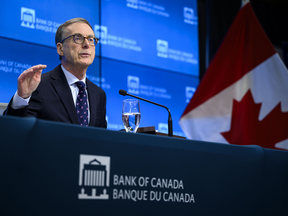Kevin Carmichael: Among the challenges is explaining why interest rates are staying near zero when inflation is above target
Article content
Bank of Canada governor Tiff Macklem was starting down the long path to an economics PhD when interest rates breached 20 per cent in the early 1980s. Back then, Finance Minister Chrystia Freeland was a teenager helping out on the family farm in Alberta.
Both of Canada’s key economic policy-makers would have been old enough to understand the gravity of the situation, but maybe not yet at an age that would have allowed them to feel what it was like during those years, as they were unburdened by adult concerns such as holding down a job or managing a payroll.
But Wayne Easter remembers. The 71-year-old chair of the House finance committee was trying to keep the family dairy farm in North Wiltshire, P.E.I., from going under. It was hell.
“I would say, ‘Governor, I’m sure glad we’re learning from the lessons of history,’” Easter, a Liberal, said during Macklem’s testimony at his committee on April 27. “I’m one, and there may be others on this committee, who faced a 23-per-cent interest rate in the 1980s and I’ll tell you we paid for that for a very long time.”
Advertisement
This advertisement has not loaded yet, but your article continues below.
Article content
Macklem, who turns 60 next month, and Freeland, 52, are making the old-timers nervous.
One of the biggest challenges Macklem and Freeland face will be convincing skeptics that they know what they are doing
The combination of the Bank of Canada’s loose monetary policy and the federal government’s massive spending is a necessary response to an epic catastrophe. There’s an echo of the 1960s and 1970s, a period that inspired the music of Leonard Cohen, Joni Mitchell and Neil Young, but ended in one of the worst recessions in Canadian history.
Classic rock is still in heavy rotation in Ottawa, but the institutional memory of what happened to the economy during those years is getting hazy. The current generation of mandarins are veterans of the Great Recession circa 2009 and the deficit fights of the 1990s. For many, double-digit inflation and interest rates are mythical creatures that exist in textbooks, but are otherwise extinct.
That’s why the extraordinary policies that make sense in the office buildings that line Wellington Street seem crazy to many of those who have seen double-digit inflation with their own eyes. One of the biggest challenges that Macklem and Freeland face over the next few months will be convincing skeptics that they know what they are doing.
They have both had months to remember. Freeland presented her first budget on April 19, setting out plans to spend another $100 billion, which will push the debt above $1 trillion, or about 50 per cent of gross domestic product.
Macklem followed two days later with a revised outlook that shows the economy surged out of the second wave of coronavirus infections. The central bank said it would taper purchases of Government of Canada bonds. It also brought forward by several months the point at which it will start considering whether to raise the benchmark interest rate. The window now opens in the second half of 2022, much earlier than the previous estimate of sometime in 2023.
Advertisement
This advertisement has not loaded yet, but your article continues below.
Article content
Of the two, Freeland seems to be having the easier time getting her message to stick. Budget commentary has faded surprisingly fast. There’s some low-level grumbling, but most of us appear to have refocused on the third wave of COVID-19 infections. Freeland also got a boost from S&P Global Ratings, which on April 26 re-upped Canada’s AAA credit rating, despite all the new spending.

Macklem is dealing with more turbulence. The exchange rate jumped to 81 U.S. cents, the highest in several years, even though he has emphasized that he plans to keep interest rates pinned near zero for a long time yet. The currency is tracking surging commodity prices, but its recent ascent will hurt some exporters.
Currency traders could be betting that inflation pressure will force Macklem to act sooner than he wants. The latest outlook forecasts the consumer price index will rise at an annual rate of 2.4 per cent in the fourth quarter of 2023, suggesting policy-makers are comfortable letting inflation drift past their two-per-cent target. Some think they’ll lose their grip.
“We have a control band of one to three per cent and we’re prepared to use it,” Macklem told the finance committee.
That’s a more complicated message than the one the public is used to hearing from the central bank. Monetary policy is complicated, but officials like to make it sound simple. Say they target inflation of two per cent. If prices jump higher, they’ll raise interest rates. If disinflation occurs, they’ll cut interest rates to get the economy back on track.
Advertisement
This advertisement has not loaded yet, but your article continues below.
Article content

Canada’s economy was overdue for a positive shock — an historic budget might do the trick

Former industry minister takes parting shot at Canada’s risk-averse business community

How the often neglected hewers of wood and drawers of water are saving Canada some pain
Among the challenges Macklem and his advisers face in the short term will be explaining why they intend to keep the benchmark rate near zero even though the consumer price index (CPI) rose to 2.2 per cent — above the target — in March. The reason is math. The base month for the CPI was March 2020, when the economy collapsed and the official inflation rate plunged to 0.9 per cent. In other words, the current reading is illusory. The economy remains fragile.
“If you withdraw stimulus prematurely, the recovery stalls and then you have to put in some new stimulus to get it back,” Macklem said. “You then lose the momentum and you have to restart it. That is certainly a lesson that we’ve all taken to heart.”
But Macklem is no dove. He first joined the Bank of Canada as a hotshot economist in the mid-1980s when the wounds from the events that so marked Wayne Easter were still fresh. He participated in the research that resulted in the central bank’s answer to the mistakes of the 1970s: the inflation target, which was introduced in the early 1990s. Macklem told the finance committee that the “other lesson of history” is that you don’t want to overheat the economy.
That last comment seemed to reassure Easter, at least for now.
“Lessons from history are a good thing,” he said.
• Email: kcarmichael@postmedia.com | Twitter: carmichaelkevin
Advertisement
This advertisement has not loaded yet, but your article continues below.
The Bank of Canada might have to tighten its messaging to allay worries about inflation
2021-05-03 09:50:16





